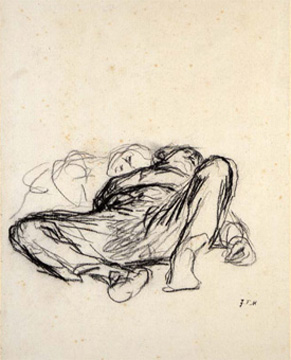Two Sleeping Figures, by Jean-François Millet, shows a sleeping couple from a frontally oriented, foreshortened perspective. The male figure, darkly wrought in charcoal, lies at the center of the drawing flat on his back with his bent knees spread apart, having fallen wide open during a midday slumber.[i] Sleeping on the ground with his legs suggestively splayed, the male figure has been compared to similar sleeping figures in Pieter Bruegel’s Land of Cockaigne—a possible source of inspiration.
Though indicated in a sketch of tangled lines, a second figure lies serenely beside the man, lightly resting her head on his shoulder or chest. While the economy of line and lack of detail do not clearly describe this second figure, the intimacy of her position relative to the male figure suggests a sexual relationship between them. Like most of Millet’s work following his move from Paris to the French countryside around 1850, Two Sleeping Figures shows a scene from rural peasant life in Barbizon. Here, a peasant couple sleeps restfully after a morning of labor in the fields.
Millet first developed the theme of the noonday rest in the 1850s, as part of the series The Four Times of Day.[ii] In his celebrated 1866 pastel La Méridienne, now at the Boston Museum of Fine Arts, Millet depicted the sleeping man and woman alongside one another atop tied bundles of hay. The Boston version, showing the couple from the side, inspired works on the same subject by Vincent van Gogh and Pablo Picasso.
Millet plotted the same sleeping peasant couple in his 1865 version of La Méridienne, now at the Philadelphia Museum of Art, in the exact manner that he composed them in Two Sleeping Figures. The Ashmolean study is one of two preliminary charcoal studies of this foreshortened rendering of La Méridienne. The other is an extremely similar charcoal study in the Art Institute of Chicago, which depicts the male figure alone.
Robert Herbert makes the apt suggestion that the “hesitant” sketched lines in these drawings expose the artist’s process: rather than containing his subject in clear delineation, Millet was formally “groping” to render their forms.[iii] Indicated, but hardly articulated, the schematic scribble of the female figure in Two Sleeping Figures further shows how Millet was working out the spatial relationships of the figures in this compositional study for the Philadelphia pastel.
[i] Robert Herbert argues that the position of the sleeping male figure was inspired by Pieter Bruegel’s Land of Cockaigne. Bruegel is the “artist who looms largest” in Millet’s post-1850 work, according to Herbert. In fact, Millet owned several oils attributed to him. Robert Herbert, “City vs. Country,” ArtForum, vol. 8, no. 6 (February 1970), 50.
[ii] Colin Hanson, Line and Colour: 19th Century French Drawings from the Collection of the Ashmolean Museum, Oxford, exh. cat. (Tokyo: Station Gallery, 1997), 148.
[iii] Robert Herbert, “Millet Reconsidered,” Museum Studies [Art Institute Chicago], 1966, 41.
Adina Loeb

